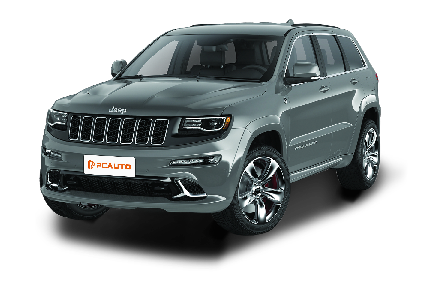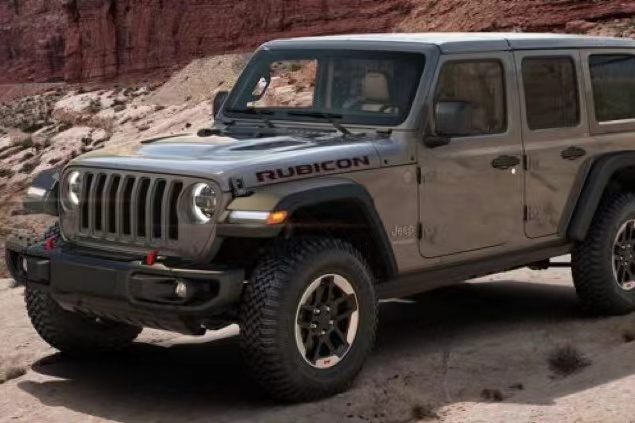Q
Is the Jeep Grand Cherokee SRT a good car?
The Jeep Grand Cherokee SRT can be considered a good car. It's powered by a 6.4L V8 engine that churns out 461 PS of maximum power and 624 N·m of torque, enabling a 0 - 100km/h acceleration in just 5 seconds, providing strong and exhilarating performance on the road. It comes with an 8 - speed AT gearbox and All Wheel Drive system, offering good handling and traction. Safety features are also well - equipped, with 7 airbags, ABS, and body stability control as standard.
The interior features an 8.4 - inch touchscreen and 19 Harman Kardon speakers, delivering a comfortable and high - quality driving environment. The vehicle has a 93 - liter fuel tank and a spacious 990 - liter trunk. However, it has a relatively high fuel consumption rate of 14L/100km. But if you're someone who values performance, power, and a luxurious driving experience, and don't mind the fuel cost, the Jeep Grand Cherokee SRT is a great choice.
Special Disclaimer: This content is published by users and does not represent the views or position of PCauto.
Related Q&A
Q
What is the most common problem with the Jeep Grand Cherokee?
In Malaysia, one of the more common issues reported with the Jeep Grand Cherokee involves electronic system malfunctions—particularly instrument cluster display errors, central touchscreen freezes, or malfunctioning reverse cameras. These problems are often related to software compatibility or sensor sensitivity and can usually be resolved through system updates at authorized service centers.
In addition, some owners have reported that the air suspension system may develop air leaks or experience slow height adjustments after prolonged use. This is often linked to accelerated aging of rubber components in the tropical climate. Regular inspection of the suspension lines and seals can help prevent such issues. From a powertrain perspective, the 3.6L Pentastar engine is prone to carbon buildup in hot and humid conditions if not properly maintained. For Malaysian owners, it is advisable to shorten the service interval to every 8,000 km and use fully synthetic engine oil.
Notably, the Grand Cherokee’s four-wheel-drive system performs exceptionally well during Malaysia’s rainy season. However, transfer case fluid should be replaced strictly according to the maintenance schedule to prevent moisture-related damage. Owners should also ensure that sunroof drainage channels are kept clean to avoid water leaks into the cabin during heavy rains. Overall, with a maintenance strategy tailored to tropical conditions, this American SUV can deliver reliable performance to meet daily driving needs.
Q
Is the Jeep Grand Cherokee SRT AWD?
Yes, the Jeep Grand Cherokee SRT is equipped with All Wheel Drive (AWD). This AWD system enhances traction and stability, proving particularly advantageous across various driving conditions. Whether navigating wet or slippery roads during Malaysia's rainy seasons or seeking improved control when cornering on regular roads, the AWD system dynamically distributes power to all four wheels as needed. This optimizes vehicle handling while minimizing wheel spin risk. Furthermore, it enhances acceleration performance, enabling the 461-horsepower engine to efficiently transfer power to the road surface for a smooth and confident driving experience.
Q
Does the Jeep Grand Cherokee SRT have a Hellcat engine?
The Jeep Grand Cherokee SRT does not have a Hellcat engine. The Hellcat engine is typically associated with certain models of Dodge, such as the Dodge Challenger SRT Hellcat and Dodge Charger SRT Hellcat. These Dodge models are known for their high-performance capabilities, with the Hellcat engine delivering substantial horsepower and torque.
The Jeep Grand Cherokee SRT is equipped with a 6.4-liter V8 engine. It can generate 461 horsepower and 624 Nm of torque. This engine provides the Grand Cherokee SRT with strong acceleration and performance suitable for an executive-class vehicle. While both the Hellcat-powered Dodges and the Jeep Grand Cherokee SRT offer high performance, they have different powertrain configurations and characteristics to suit various driving preferences and needs.
Q
How much is the Jeep Grand Cherokee SRT worth?
The Jeep Grand Cherokee SRT is priced at RM 698,889. This vehicle delivers powerful performance with its 6.4-liter V8 engine that generates 461 horsepower and 624 Nm of torque. It can accelerate from 0 to 100 km/h in just 5 seconds. Equipped with an 8-speed automatic transmission and all-wheel drive, it offers excellent handling and traction. The interior is well-appointed, featuring a Harman Kardon sound system with 19 speakers, a power panoramic sunroof, dual-zone automatic climate control, and various safety features including 7 airbags. It also has a sizable 93-liter fuel tank and a spacious 990-liter trunk, making it suitable for both daily commutes and long journeys.
Q
What is the difference between the Grand Cherokee SRT and Limited?
The Grand Cherokee SRT and Limited have several differences. The SRT is a high-performance model, powered by a 6.4L V8 engine that delivers 461 horsepower and 624 N·m of torque, enabling it to accelerate from 0 to 100 km/h in just 5 seconds. It's priced at RM 698,889. It features sporty elements like a lowered body with aerodynamic kits and Brembo brakes for enhanced handling. The interior incorporates sporty materials.
On the other hand, the Limited prioritizes comfort and luxury. It comes with premium interior materials such as genuine leather seats and wood trim. Standard features include a panoramic sunroof, a BOSE sound system, and intelligent driving assistance systems. It offers a more refined and comfortable driving experience rather than extreme performance. So, if you desire speed and a sporty drive, the SRT is ideal; but if luxury and comfort are your priorities, the Limited would be a better fit.
Q
How many Jeep Grand Cherokee SRT were made?
Sorry, no information about the specific production volume of the Jeep Grand Cherokee SRT was found. The Jeep Grand Cherokee SRT is a high-performance luxury SUV, renowned for its powerful engine and excellent off-road capabilities. Take the 2015 Jeep Grand Cherokee SRT 6.4 V8 as an example: it is equipped with a 6.4L V8 naturally aspirated engine delivering a maximum power output of 339 kilowatts (461 PS), achieving the 0-100 km/h sprint in just 5 seconds officially. The vehicle features a range of advanced technologies and comfort amenities, including an 8.4-inch central touchscreen and Harman Kardon audio system, along with comprehensive safety provisions such as seven airbags and electronic stability control. While its exact production figures remain undisclosed, this model has garnered significant attention in the automotive market due to its distinctive appeal.
Q
What was the last year of the Grand Cherokee SRT?
2021 was the last recorded model year of the Grand Cherokee SRT available in the local market. It is powered by a 6.4L HEMI V8 engine delivering 461 horsepower (461PS) and 339 kilowatts of maximum power. With robust performance capabilities, it achieves 0-100km/h acceleration in under 5 seconds. Featuring an All-Wheel Drive system paired with independent front/rear suspensions and ventilated disc brakes, the vehicle demonstrates exceptional handling and braking performance. The well-appointed interior includes seven airbags for safety protection, a 19-speaker Harman Kardon premium audio system, along with comfort features such as a panoramic sunroof and heated seats. While this represents the final model year available, actual market availability may vary across different used vehicle sources. Prospective buyers should verify specific vehicle details through multiple channels when purchasing pre-owned units.
Q
How much HP does a Grand Cherokee SRT have?
The Jeep Grand Cherokee SRT 6.4 V8 delivers 461 horsepower (PS). This potent engine provides the vehicle with robust acceleration and road performance. Its 6.4-liter V8 engine generates a maximum torque of 624 N·m at 4100 rpm, reaching peak power output of 339 kW at 6250 rpm. This power enables the Grand Cherokee SRT to accelerate from 0 to 100 km/h in merely 5 seconds. It delivers an exhilarating driving experience whether overtaking on highways or enjoying spirited driving. Additionally, its performance is enhanced by features such as an 8-speed automatic transmission and All-Wheel Drive system, improving both handling and traction for comprehensive driving dynamics.
Q
Can you turbo a Jeep SRT?
Technically, it is possible to turbocharge a Jeep SRT. However, it's a complex modification. The Jeep Grand Cherokee SRT comes with a 6.4L naturally aspirated V8 engine that already delivers substantial power at 461 horsepower. Turbocharging involves adding a turbocharger to the engine to force more air into the combustion chambers, thereby increasing power output. However, such modifications require careful consideration as they impact multiple components including the engine internals, fuel system, and cooling system. For example, the stock fuel injectors may not supply sufficient fuel for the increased air intake, and the cooling system might struggle to manage the additional heat generated. Additionally, turbocharging could void the vehicle's warranty. Proper tuning is also critical to ensure smooth and efficient engine operation. Incorrect tuning may lead to performance issues or even engine damage. Therefore, while feasible, this modification should only be performed by experienced mechanics with expertise in the Jeep SRT's engine dynamics.
Q
Is a SRT Jeep a V6?
An SRT Jeep is not equipped with a V6 engine. Take the 2015 Jeep Grand Cherokee SRT as an example—it is powered by a 6.4L V8 engine with a displacement of 6417mL, delivering 461 horsepower and 624 N·m of torque. This V8 engine provides the vehicle with robust power output, enabling it to accelerate from 0 to 100 km/h in just 5 seconds. The V8 configuration also contributes to a smooth and powerful driving experience, whether for daily commuting or more demanding driving scenarios. In contrast, a V6 engine typically has fewer cylinders and generally offers less power and torque compared to a V8 engine of the same displacement.
Latest Q&A
Q
How much will 2025 Tucson cost?
The exact pricing for the 2025 Tucson hasn’t been announced yet, but based on the current model’s price range and its positioning in the compact SUV segment, we expect a starting price between RM140,000 and RM180,000. Final figures will vary depending on trim levels and optional extras.
The new model is likely to feature upgraded driver-assist tech, including more advanced lane-keeping and adaptive cruise control. Inside, we could see improved materials, a larger infotainment screen, and added convenience features like wireless charging.
With the compact SUV market getting more competitive, brands are packing in better tech while keeping prices sharp. If you’re interested, keep an eye out for official updates or check with local dealers for the latest offers. It’s also worth comparing specs and pricing against rivals to make the right choice.
Q
Will the Hyundai Tucson change in 2025?
Based on current information, the 2025 Hyundai Tucson is expected to receive several updates, likely including subtle exterior styling tweaks, interior upgrades, and enhanced tech features—such as a more advanced infotainment system or driver-assistance technologies. However, official details are still pending.
Hyundai typically refines design language and boosts tech offerings during mid-cycle updates, so the new Tucson may feature sharper lighting signatures or a larger touchscreen while retaining existing powertrain options, including gasoline and hybrid variants.
For buyers prioritizing practicality and technology, the Tucson has always been a solid value proposition in its class, offering spacious interiors and generous standard features that cater well to families. The refreshed model could further strengthen these strengths.
If you're considering a purchase, keep an eye out for official updates later this year to confirm specs and launch timing. It’s also worth cross-shopping rivals in the segment to ensure you’re choosing the right SUV for your needs.
Q
What is the resale value of a 2018 CLA?
**2018 Mercedes-Benz CLA Used Value Guide**
The resale value of a 2018 CLA depends on factors like condition, mileage, specs, and service history, typically ranging between RM100k to RM150k—exact pricing requires an in-person inspection. Thanks to the Mercedes badge and its coupe-like styling, the CLA holds decent demand in the used market, especially low-mileage examples with full maintenance records.
Key factors affecting price:
- Complete service history (dealer stamps preferred)
- Remaining factory warranty
- Exterior color (popular shades like black/white may command slightly more)
- AMG Line or higher trims can add 5-10% over base models
Note: Luxury cars take the biggest depreciation hit in the first 3 years, but the CLA (being an entry-level model) retains value better than most. Before selling, get a professional inspection and organize all receipts—it helps justify your asking price.
For reference, check comparable Audi A3 or BMW 2 Series listings, though the CLA’s frameless doors and brand appeal often give it a slight edge. For the most accurate valuation, review recent transactions on local used car platforms or visit an official Mercedes-Benz Certified Pre-Owned dealer.
Q
How much is a 2018 CLA 250 worth?
Here's a natural-sounding translation from an automotive editor's perspective:
"The 2018 CLA 250 currently holds a market value of around RM150k to RM180k, depending on factors like condition, mileage, specs, and service history. Well-maintained models with low mileage can fetch prices near the top end, while those with visible wear or accident records may drop significantly.
As Mercedes-Benz’s entry-level coupe, the CLA 250 packs a 2.0L turbocharged engine delivering 208hp and 350Nm of torque, paired with a 7-speed dual-clutch transmission. It offers sharp handling and lively performance—ideal for drivers who enjoy a sporty feel.
Inside, you’ll find a refined cabin with standard features like a multimedia system and reversing camera. Higher-spec variants might add extras like a sunroof or premium audio.
If you’re shopping for a used unit, always check maintenance records and get a professional inspection on critical components (engine, gearbox, etc.). For context, cross-shop rivals like the A 250 or BMW 2 Series from the same year to weigh your options thoroughly."
(Note: Adjusted "RM" placement for natural flow and trimmed some redundant phrasing while keeping the technical details and conversational tone.)
Q
What is the maintenance cost for a 2018 CLA?
**Maintenance Costs for the 2018 CLA**
The maintenance costs for a 2018 CLA can vary depending on the vehicle’s condition, mileage, and the services required. A standard service typically includes basic items like an oil and filter change, which may cost between RM 800 to RM 1,500—depending on the type of oil used and whether you go to an authorized dealer or a third-party workshop.
If additional services are needed, such as brake fluid replacement, air filter changes, or tire rotation, the cost could go up to around RM 2,000 to RM 3,000. To keep the car running smoothly, it’s recommended to service the CLA every 10,000 km or 12 months, whichever comes first.
As a luxury model, the CLA’s parts and labor costs may be slightly higher than mainstream brands. However, sticking to regular maintenance helps extend the car’s lifespan and prevents costly repairs down the road. To save on expenses, owners can consider prepaid service packages or reputable independent workshops. Just make sure to keep full service records—it’ll help maintain the car’s resale value.
View More



















Pros
Cons